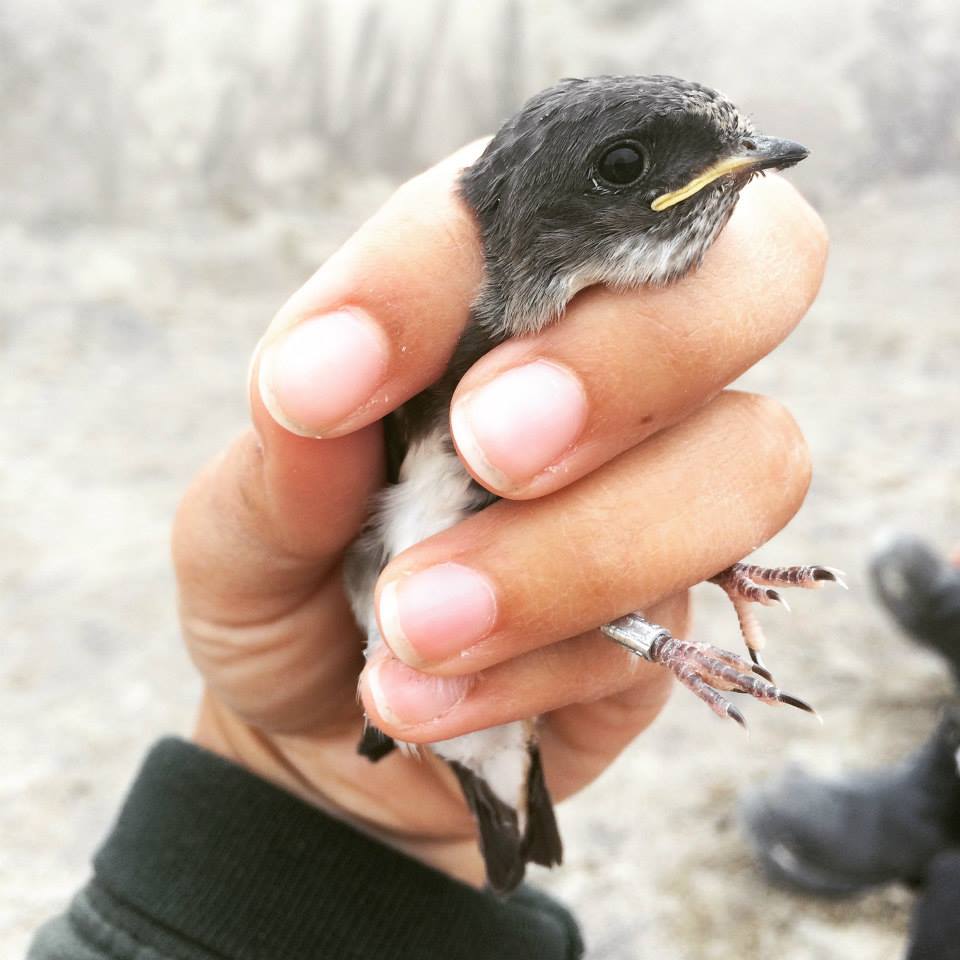By Tianna Burke
Linked paper: Reproductive success and health of breeding Bank Swallows (Riparia riparia) in aggregate (sand and gravel) pit and natural lakeshore habitats by T.R. Burke, M.D. Cadman, and E. Nol, The Condor: Ornithological Applications.
Sand and gravel pits, also known as aggregate pits, may seem like an unlikely place to nest, but for Bank Swallows this habitat greatly resembles their natural habitat of sandy banks along rivers and lakeshores. In Ontario, an estimated 126,448 breeding pairs nest in these aggregate pits. Since Bank Swallows became a Species at Risk in Ontario, researchers have been looking more into what could be done to assist with their conservation, and an increase in available habitat must be good, right?
If you can hear Admiral Ackbar yelling “it’s a trap!” in your head, that’s exactly what we aimed to find out. Encouraging Bank Swallows to nest in sites that result in low reproductive success or health would be sending them into an ecological trap, which is what biologists call it when individuals choose to settle in a habitat even though they do poorly there compared to other, higher-quality habitat. So before encouraging aggregate pit operators to manage their sites for Bank Swallows, we thought it would be important to first investigate whether these sites can provide suitable high-quality breeding habitat.

We carried out our research in pits surrounding Peterborough, Ontario, and lakeshore habitat on the north shore of Lake Ontario. In the first part of the study, we monitored nests to determine egg lay dates and nesting success in order to test the prediction that Bank Swallows would reproduce more successfully in lakeshore habitats. We found that there were more unsuccessful nests in aggregate pits, likely because of burrow collapse from the face of the pit slumping and/or the number of mammalian predators that we observed excavating and depredating lower burrows. However, aggregate pit nests raised more young per successful nest than those on the lakeshore, which means they could be good habitat if operators of aggregate pits managed sites to target the issues of predators and bank slumping.
In the second part of the study, we collected size, weight, and ectoparasite data from individual adult and juvenile Bank Swallows that were banded to test the prediction that Bank Swallows nesting on the lakeshore would have a higher mass and more ectoparasites than those nesting in pits. We predicted this because parasite transmission is usually much more efficient in large colonies like those at the lake, and the lake sites tend to be more stable over time than the pit sites, meaning they can potentially harbour parasites from one year to the next. Fledgling Bank Swallows did not differ in weight, suggesting that adults in both types of habitat could provide for their young. However, although the mass of adults nesting at lakeshore colonies did not change throughout the breeding season, the mass of adults in aggregate pits decreased as the breeding season progressed. This suggests that even though Bank Swallows nesting in aggregate pits can provide for their young, they can’t maintain their own body weight at the same time. When looking at ectoparasites in both habitat types, we found that Bank Swallows nesting in aggregate pits had fewer ectoparasites, supporting our prediction.
So are aggregate pits an ecological trap for Bank Swallows? It’s still hard to say. It will be important to replicate this work in other areas throughout the hemisphere and to look further into some of the interesting results we found, such as what happens to lighter-weight adults after the breeding season. Though there are still many unknowns, as long as aggregate pit operators provide attractive habitat for Bank Swallows, they will inevitably nest there. Since predators and the slumping of banks seemed to play an important role in the fate of our nests, we suggest that aggregate pit operators should begin to manage their sites to deter predators and reduce instances of slumping.

Anecdotal add-on: At a construction site some years ago, a friend and I noticed that Bank Swallows were using a “borrow pit” soil disposal site (a large heap of soil dug out of a foundation to be used as fill in another area of a department store construction site). The contractors were taking scoops of material and leaving long vertical edges to the heap piles. Bank Swallows moved in. There were about 100 active nests. We went over to the General Contractor’s work-site office and spoke with the boss. He was totally into changing the work schedule to allow the swallows to complete their nest cycle. We shared the good news with the local newspaper which followed up with a wonderful PR plus for the contractor and the big deal retail client. It worked. Hundreds of swallow nests were successful. As it happened, many of the swallow pairs opted to produce a second brood. The contractor willingly, but somewhat begrudgingly went along with his cooperative gesture – another two-week delay in a critical phase in the construction schedule. He had other options to work on in the meantime. He drew the line at the prospect of a third brood. We gave the GC a copy of Birds of Pennsylvania (his home state) and received a reprimand from our commissioner (the State Environmental Department) for getting involved in private business activities (the newspaper mentioned our employment situation).
This morning swallows were actively hunting insects along the edge of an abandoned aggregate pit. The height of the sandy ridge line that runs for half a I’m or so is at least 25 metres and this was the edge line they were feeding along. I was unaware that these swallows were an “identified” in Ontario as being at risk. I will be taking a better pair of binoculars along next time to confirm if these are indeed bank and not tree swallows. An interesting and important study. All the best.